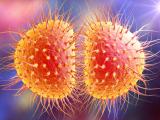A study published today in mSphere shows that the same strain of gonorrhea is expressed differently in men and women, a finding that may have implications for fighting growing antimicrobial resistance in one of the most common sexually transmitted infections (STIs).
"We were initially interested in studying gonorrhea in women because unlike men, women don't have symptoms," said Caroline A. Genco, MS, PhD, the chair of the department of immunology at Tufts University School of Medicine and senior author of the study in an interview with CIDRAP News. "But they can transmit to a partner, their infections can lead to pelvic inflammatory disease, or even an ectopic pregnancy."
To Genco, it was clear that men and women had a different inflammatory response to Neisseria gonorrhoeae.
A unique study setting
A team of US researchers conducted the study in a STI clinic in China, pairing husbands and wives, or partners, infected with the same strain of gonorrhea. Genco explained the study setting: Animal models for gonorrhea are lacking, and Chinese STI clinics offered a paired-match opportunity for comparing men and women.
"In the US, people with gonorrhea tend to be young and with multiple partners, but in China, we usually see a man who has contracted the STI from a mistress or a sex worker who then passes it to his monogamous wife."
China also has high rates of gonorrhea and antimicrobial resistance, made worse by the availability of over-the-counter antibiotics.
Expression difference details
The study included a total of six male subjects (average age, 34 years) attending the Nanjing Sexually Transmitted Disease (STD) Clinic, who presented with urethral discharge and pain. Three of the six men had taken self-administered antibiotics prior to the clinic visit.
The men were paired with seven women partners, none of whom were symptomatic or had taken antibiotics prior to the visit. Specimens were taken directly from partners for genetic sequencing.
Though the study was small, the results were clear: RNA sequencing analysis revealed that 9.4% of gonococcal genes showed increased expression exclusively in men and included genes involved in host immune cell interactions, while 4.3% showed increased expression exclusively in women and included phage-associated genes. Men also had a 4-fold higher expression of certain antimicrobial resistance genes.
"These results suggest that expression of AMR genes is programed genotypically and also driven by sex-specific environments," the authors write.
"This is a major finding," said Genco. "There are clinical implications, including that asymptomatic women may be more effectively treated with antibiotics than men. This means maybe we tailor dose and drugs based on a patient's sex."
Next phase of study brings in more subjects
Genco said her group was currently enrolling another 144 subjects and is continuing to analyze data from genetic samples.
One area that begs further study, she said, is women's vaginal flora and microbiome, which may have protective features against gonorrhea.
The World Health Organization estimates that 78 million people worldwide are infected with gonorrhea. Rates of the STI have increased in the states in the last decade, and in 2013, the Centers for Disease Control and Prevention listed drug-resistant N. gonorrhoeae as an urgent public health threat.
See also:
Jun 27 mSphere study





















